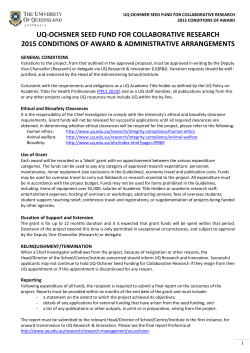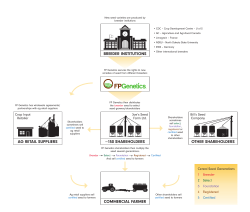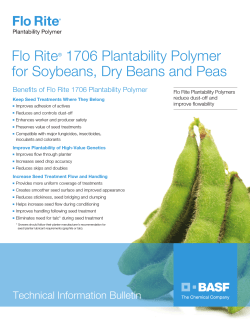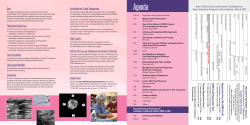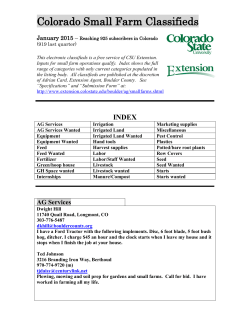
AMERICAN CHEMICAL SOCIETY CALIFORNIA SECTION
AMERICAN CHEMICAL SOCIETY VOLUME LXXVI NUMBER 3 CALIFORNIA SECTION MARCH 2015 Bob Fabini, chemistry teacher, El Cerrito HS, Dr. Elaine Yamaguchi, Project SEED Coordinator, and Joseph Baba, student El Cerrito HS (article on page 4) MARCH SECTION MEETING CHAIR’S MESSAGE PROJECT SEED SCIENCE CAFE PROBLEMS WITH PRIONS PART I (W. MOTZER) EARTH DAY FAMILY SCIENCE NIGHT (VOLUNTEERS NEEDED) EARTH DAY & CENTENIAL CELEBRATION BUSINESS DIRECTORY INDEX OF ADVERTISERS PAGE 2 PAGE 3 PAGE 4 PAGE 5 PAGE 6 PAGE 8 PAGE 10 PAGE 10 PAGE 11 PAGE 11 California Section ACS-March Section Meeting "Starting a Biotech in the midst of the Great Recession” Speaker: Dr. Dan Erlanson, President, Carmot Therapeutics, San Francisco Sponsored by Xcelience Date: Tuesday, March 10, 2015 Time: 5:30 pm-Reception, 6:00 pm-Dinner, Section Meeting, Presentation, Q&A - 7:00 – 8:15 pm Place: Pyramid Alehouse, 901 Gilman Street, Berkeley CA 94710. Cost: $30. (Students $15.). Reservations: Required. Email to office@calacs.org or phone 510-351-9922. You may prepay by sending a check to Cal. Section, ACS, 2950 Merced Street, #225, San Leandro CA 94577 or by Paypal by going to http://www.paypal.com > Send Money > Send Money Online > To: office@calacs.org and follow the instructions. You may also pay at the event with cash or a check (credit cards are not accepted). RSVP: By Monday, March 2, 2015 Directions: from I-80 or I-580; Take Gilman St. exit and go East, restaurant is between 7th and 8th St on left. Buffet Style dinner will be served which includes: Mixed Green Salad, Sautéed Seasonal Vegetables, Roasted Red Mashed Potatoes & Gravy, Roasted Chicken with herb butter sauce, Apricot Ale Glazed Salmon, and Butternut Squash Ravioli with Sage Cream Sauce. Abstract: Carmot Therapeutics was founded in 2008, in the midst of what would come to be known as The Great Recession. This presentation will discuss how it is possible to bootstrap a biotech company even as the financial world appears to be melting down. Carmot Therapeutics is built on Chemotype Evolution, a proprietary technology that dramatically expands the repertoire of chemical diversity for drug discovery. This fragment-based approach involves physically making and testing thousands of new molecules custom-designed for a given target. The approach is target-agnostic and rapidly accesses novel and targetrelevant chemical diversity, providing the opportunity to tackle therapeutic targets refractor y to traditional approaches. Carmot is using Chemotype Evolution to identify innovative drugs for challenging therapeutic targets, thereby addressing important unmet chemical needs. Carmot has been supported by grants, venture capital, and partnerships with other drug companies. MARCH 2015 Biography: Dr. Daniel A. Erlanson is the co-founder of Carmot Therapeutics, Inc. (http://www. carmot.us), a small-molecule drug discovery firm. Prior to Carmot, Dr. Erlanson spent a decade developing fragment-based drug discovery technologies and leading medicinal chemistry efforts in oncology, metabolic, and inflammatory diseases at Sunesis Pharmaceuticals, which he joined at the company’s inception. Before Sunesis, he was an NIH postdoctoral fellow with James A. Wells at Genentech. Dr. Erlanson earned his PhD in chemistry from Harvard University in the laboratory of Gregory L. Verdine and his BA in chemistry from Carleton College. As well as co-editing the first book on fragment-based drug discovery, Dr. Erlanson is an inventor on more than a dozen issued patents and published patent applications, an author of more than thirty scientific publications, and has presented at more than fifty national and international conferences. He also runs a blog devoted to fragment-based drug discovery, Practical Fragments (http:// practicalfragments.blogspot.com/). PAGE 2 THE VORTEX Published monthly except July & August by the California Section, American Chemical Society. Opinions expressed by the editors or contributors to THE VORTEX do not necessarily reflect the official position of the Section. The publisher reserves the right to reject copy submitted. Subscription included in $13 annual dues payment. Nonmember subscription $15. MAGAZINE OF THE CALIFORNIA SECTION, AMERICAN CHEMICAL SOCIETY EDITOR: Louis A. Rigali 255 4th St. Ste #101 Oakland 94607 ADVERTISING MANAGER: Vince Gale, MBO Services Box 1150 Marshfield MA 02050-1150 OFFICE ADMINISTRATIVE MANAGER Julie Mason 2950 Merced St. # 225 San Leandro CA 94577 PRINTER: Quantity Postcards 255 4th Street #101 Oakland CA 94607 Printed in USA on recycled paper 510-268-9933 781-837-0424 510-351-9922 510-268-9933 For advertising and subscription information, call the California Section Office, 510 351 9922, California Section Web Site: http://www.calacs.org Chair’s Message Time marches on and with that basic premise here we are in March of the year 2015. With this message, I am both delighted and saddened to reflect on changes that have occurred within the CALACS community during the past month. First, reflecting on the sad news, I am sure that by now you have heard that one of the most famous organic chemists in the world, Dr. Carl Djerassi, passed away on January 30, 2015 in his home in San Francisco at the age of 91. Yes, he was a member of our section, the California section of the ACS. Of course, his contributions and influence regarding the chemistry of birth control, world-wide reproductive health and policy as well as his literary achievements and financial support for the arts have been documented on a national and worldwide level in the news media. I have a more personal account: I had the pleasure of interacting with Dr. Djerassi over several months while organizing our October 21, 2014 section meeting which was centered around his play “Insufficiency” and was performed at Z-Space, a small theater near the Mission district in San Francisco. This was likely Dr. Djerassi’s last official ACS PAGE 3 CONTRIBUTING EDITORS: Evaldo Kothny William Motzer EDITORIAL STAFF: Charles Gluchowski Evaldo Kothny Lee Latimer Alex Madonik Margareta Sequin Linda Wraxall Wally Yokoyama California Section Webstore: http://calacs.deco-apparel.com/ activity. I had never met nor spoken with Dr. Djerassi prior to Oct 21 - rather, we had a wonderful series of email communications over several months while planning the event. He was engaging, always responded promptly to my email queries and requests and offered up useful suggestions as well. At the event, which was attended by about 70 members and friends, he was great to interact with. During the evening, while physically weak, he signed autographs of his most recent autobiography and was very sharp when answering questions from the audience during a post play discussion on “Chemistry in the Arts”. During the discussion, I was joined by Jeff Seeman who has written a number of articles about Dr. Djerassi published in C&E News and other publications. Overall, it was a very memorable event, certainly for me and hopefully for all the other participants as well. I continued communicating with him into December 2014 when things became very hectic for me. However, his responses to my emails were not as prompt as they had been although he did not acknowledge any issues. January went by very quickly and then the shock of hearing about his death was not diminished by the fact that he had lived an incredibly productive and dynamic and long life. He was a true Renaissance man who left a massive legacy in impacting this world. On a happier note, I have noted in previous (Continued on page 10) THE VORTEX CALACS PROJECT SEED USES VIDEO TO REACH HIGH SCHOOL TEACHERS E. S. Yamaguchi, Chair, SEED Committee Children from low income families often do not have family members with college degrees to act as role models and often do not even consider a college education. Most people recognize the educational disadvantages and obstacles to higher education facing children attending schools in low income neighborhoods. It seems that this is a huge problem that only the educational establishment and government can remedy. However, Dr. Alan Nixon, a former president of the American Chemical Society and a member of the California Section of ACS, found a way for all of us to do something. In 1968 Dr. Nixon was able to start ACS Project SEED. SEED stands for Summer Experiences for the Economically Disadvantaged. Since 1968 the community, people and local businesses, have contributed funds that provide 8-10 week stipends to allow students to work in chemical laboratories while receiving an income. A study found that after their Project SEED experience about 85% of students are motivated to attend college. A former SEED student, Jessica Siu, currently working at Chevron says of the SEED experience: “I give SEED a lot of credit for why I chose to major in Chemistry in college. I did not know what major I was going to choose and was exploring my options when my chemistry teacher recommended me for this program. I participated in SEED the summer after my junior year of high school and worked in Dr. Andrew Breksa’s lab at USDA in Albany, which involved isolating limonin glucoside. After I participated in the program, I decided that I wanted a career in science.” Jessica Siu was in SEED in 2006 and went on to receive her B.S. degree in Chemistry from UC Davis. She is the first in her family to graduate from a four-year university. The Section’s Project SEED program is one of the largest in the country. In recent years the demographics of the SEED student population has changed with few students from West Contra Costa County, MARCH 2015 one of the most disadvantaged school districts in the region. One of the major obstacles to participation of students from WCCC schools for Section Project SEED organizer, Dr.Yamaguchi, is lack of or low teacher participation. Compared with other Bay Area schools, WCCC schools have a higher rate of faculty turnover. Dr. Elaine Yamaguchi, believes that lack of knowledge about the prog ram among teachers, especially new teachers, and students is the main cause for the low participation rate among WCC students. In order to reduce this barrier to participation by WCCC, Dr. Yamaguchi, has partnered with a WCCC high school chemistry teacher to make a short documentary video of the experiences of SEED students in laboratories during the Summer of 2014. The video was produced with the help of Joseph Baba, El Cerrito High School student film maker, Robert Fabini, El Cerrito High School chemistry teacher, Michael Hundt, Silicon Image, retired, video editor, Lowell-James Hicks, audio engineer. Thanks to the USDA Albany for allowing us to film in their labs, Chevron Oronite Company, Richmond, for handling distribution of the DVD to all WCC chemistry teachers, Dr. Andrew Breksa, USDA chemist and co-coordinator of SEED, and Ken Nelson, Chevron Oronite chemist and co-coordinator of SEED. These students need your help to even the playing field to higher education. The stipend for SEED I and II students are $2500 and $3000, respectively, for 9 weeks. The annual budget to fund 45 students is about $120,000. We have been very fortunate to have individuals and companies step up to provide the funds that change the lives of these students and we could use your help. Every donation, $20, $50, or $100, is appreciated. If you want to help the CA Section SEED Program, the easiest way to make a donation is to contact the CAL ACS office, 510-351-9922 or at CALACS.org. Dr. Yamaguchi says, “SEED is all about being patient with young folks who are finding their path in education and beyond high school. Please join us in supporting this effort. I will gladly receive any help I can get.” PAGE 4 Wednesday, March 4th, 2015 7:00pm to 9:00pm Community Hall - Doors Open at 6:30 Explore the Science of Future Manned Missions to Mars! New York Times bestselling author of The Martian Andy Weir joins Dr. Pascal Lee, Chairman of the Mars Institute, to discuss the science, both fact and fiction, of this sci-fi thriller. Don’t miss this far reaching conversation moderated by NASA Scientist, Dr. Margaret Race. The Martian, a feature film directed by Ridley Scott and starring Matt Damon, is scheduled to be in theaters on November 25, 2015! To pre-order a boxed meal, call the Bookmark Café at (925) 283-9999 Menu available at bookmarkcafe.com/events FUTURE OF MANNED MISSIONS TO MARS brought to you with support from the following sponsors: Mervyn L. Brenner Foundation Lafayette Library & Learning Center 3491 Mt. Diablo Blvd. Lafayette, CA 94549 (925) 385-2280 Monday-Thursday 10-8 Friday-Saturday 10-5 Sunday 1-5 PAGE 5 THE VORTEX Problems with Prions1 (Part 1) Bill Motzer Introduction Prions are considered to be single, misfolded cellsurface proteins which become “infectious” by causing normal proteins to also misfold. The term was coined by Nobel Prize winner Dr. Stanley B. Prusiner for proteinaceous infectious particle. Prion diseases are believed to belong to a variety of rare and progressive neurodegenerative disorders known as amyloidal diseases because they form amyloids or fibrils within a particular organ. Such fibrils are highly organized protein aggregates. Several degenerative diseases such as Alzheimer’s, Parkinson’s, and type II diabetes fall within this family; however, these have not been considered as “infectious.” Other human and animal prion diseases such as Creutzfeldt Jakob disease (CJD) and Bovine Spongiform Encephalaphy (BSE or “mad cow” disease) are considered infectious. Prion diseases affecting both humans and animals (Table 1) are termed transmissible spongiform encephalopathies (TSEs); these are distinguished by long incubation periods, characteristic spongiform changes (formation of large vacuoles or holes) in tissues associated with neuronal loss (particularly to the brain), and a failure to induce an inflammatory response. They have long incubation periods (2 to 8 years and even longer), are resistant to procedures that normally inactivate viruses (i.e., heat and disinfectants), are difficult to detect, and have no known successful preventions, treatments, or cures. Human prion diseases are rare but animal prion diseases are more common. Cross-species infection is also Originally published as: Prions and Their Potential to Impact Water Resources: Groundwater Resources Association of California, Spring 2011 newsletter HydroVisions, v. 20, n. 1, pp. 28-31; (http:// www.grac.org/Prions_Potential_Impact_ Water_Resources.pdf). Revised for THE VORTEX ,February 2015. 1 MARCH 2015 rare but some may occur as described below. The problem associated with TSEs is twofold: can prions that produce such diseases remain infectious after they leave the host and can they be transported in the environment (i.e., from the infected animal to soil, surface and groundwater)? This series will briefly review their characteristics in causing specific human and animal diseases, environmental transport and fate, and whether prions should be considered as an emerging contaminant of concern (ECC). Sources & Epidemiology Different types of TSEs occur in humans and animals; these are specific to strains of the infecting prion host; microbiologists use the abbreviation PrP to denote the host encoded prion. Some are summarized in Table 1 and briefly described below: Humans: Creutzfeldt-Jakob Disease (CJD), also known as classic or sporadic sCJD (i.e., PrPCJD), a very rare and fatal human prion disease results in ~250 annual cases (now totaling ~2,698 cases). Symptoms include behavioral changes, lack of coordination, and visual disturbances. In later stages, mental deterioration becomes pronounced. It is not considered communicable through casual contact. CJD has been reported in over 50 countries with clustering in some countries such as Czechoslovakia. Several types occur: Familial Creutzfeldt-Jacob Disease (fCJD) results from inherited mutations in the prion protein gene. Iatrogenic Creutzfeldt-Jacob Disease (iCJD) is caused or induced by infection f rom contaminated du ra mat ter and other tissues including bone grafts and corneal transplants. Variant CJD (vCJD), a relatively new form of CJD, affects ages 14 to 52, averaging 28 years. In the United Kingdom (U.K.) and France possible BSE (see below) transmission to humans is suspected, with well defined, clinical, and consistent features distinguishing it from sCJD. Infection may occur from bovine prions transmitted through consumption of contaminated beef. Fatal familial insomnia (FFI) and sporadic fatal insomnia (sFI) may be caused by a (continued on page 7) PAGE 6 (Motzer continued from page 6) genetic mutation but sporadic types also occur. fFI’s mutated protein has been found in just 40 families worldwide, affecting about 100 people. These are very rare, chronic and progressive degenerative central nervous system disorders, particularly of the brain. The genesis and patient’s progression into complete sleeplessness is untreatable and ultimately fatal. Alper’s syndrome is a similar brain disease affecting infants and children. Gerstmann-Straussler-Scheinker Syndrome (GSS) is another extremely rare (1-10 per 100 x 10 6 of the population) neurologic prion disease that is generally inherited, affecting specific families. Symptoms start with difficulty speaking and progress to unsteadiness and finally to dementia with memory loss (although this can be the first symptom). GSS patients show widespread neuropathological amyloidal plaques, similar to Alzheimer’s. Kuru is a condition found in the Fore tribe in the Okapa district of the Eastern Highland, Papua, New Guinea. It was transmitted and acquired when adult women and children of both sexes ate infected human tissues, particularly dead tribal members’ brains. Banning this practice, resulted in cessation of Kuru. In November 2009, Dr. Simon Mead of University College London, and others, determined in genetic and clinical assessments that Kuru survivors were carriers of a prion resistant factor, which is believed to be a source of immunity resulting from the inheritance of a genetic variant of prion protein. Neurodegenerative diseases. In 2013, Dr. Prusiner and others noted that Alzheimer’s, Parkinson’s, Amyotrophic Lateral Sclerosis (ALS or Lou Gehrig’s disease) and fronto-temporal dementias (FTD or Pick’s disease) should be considered as amyloid diseases where aberrant forms of a particular protein accumulates forming pathological plaques, neurof ibrillar y tangles, Lewy bodies, and glial cytoplasmic and/or nuclear inclusions. Most may be genetic in origin; it is not certain if cross PAGE 7 species infection occurs. Animals: Scrapie is a world-wide (except for Australia) goat and sheep prion disease known for over 200 years. It probably began in Spain and then spread through western Europe. It seems to be horizontally transmitted.2** Bovine Spongiform Encephalopathy (BSE), aka “mad cow” disease, confined almost entirely to the U.K., is believed to have been caused by meat and bone meal (MBM) derived from infected sheep, cattle, and other animals used in cattle feed. Cases were reported in Belgium, Denmark, France, Ireland, Lichtenstein, Luxemburg, the Netherlands, Portugal, and Switzerland. From 1980 – 1996, ~750,000 infected U.K. cattle were slaughtered and consumed by millions of U.K. residents. With a 1990 ban on MBM, BSE cases subsequently declined and by the close of 2014, 190,713 cases were reported with >97% occurring in the U.K. (Figure 1). BSE incidences will probably continue declining as long as no re-infections occur. Human infection risk by BSE remains unclear, but cross-species contamination is suspected in vCJD (Figure 1). Chronic Wasting Disease (CWD), with an unknown etiology, has been recognized as the only prion disease affecting captive and free-ranging deer and elk in the Rocky Mountain (and surrounding) states, and Canada (Figure 2). Contagion sources have been identified in infected animals and carcass secretions and excretions. Transmissible Mink Encephalopathy (TME) is an uncommon disease occurring in farmed mink fed with sheep and perhaps bovine offal. Within species transmission also occurs from fighting and cannibalism among young mink. ** Horizontal transmission occurs when bacterial, fungal, viral, or prion infections are between same specie members not in a parent-child relationship. Vertical transmission (aka mother-to-child transmission) occurs when an infection or other disease is transferred from mother to child immediately before and/or after birth during the perinatal period. continued from page 8 2 THE VORTEX Motzer, continued from page 7 Feline Spongiform Encephalopathy (FSE), occasionally referred to as “mad cat” disease was first reported in 1990 in a five year old U.K. Siamese cat. FSE has also been reported in zoo cats such as lions and tigers where it is known as large cat FSE (LCFSE). Transmission is unclear. In Part 2, I will discuss prion environmental t r a nspor t /fate i n soil, su r face, a nd groundwater, their transmission, toxicity, and risk, and analysis and detection. Table 1: Summary and Chronology of Some TSEs TSE Name (Abbreviation) Affected Humans/ Animals (x onset yrs) Approx. Date(s) First Observed S Type ● G A Human sporadic Creutzfeldt-Jakob Disease (sCJD) adults (60) 1920-1921 variant Creutzfeldt-Jakob Disease (vCJD) Adults (28) 1996 UK iatrogenic Creutzfeldt-Jakob Disease (iCJD) adult (30-39) 1973-2003 familial Creutzfeldt-Jakob Disease (fCJD) adult (46-55) 1924 ● Gerstmann-Straussler-Scheinker Syndrome (GSS) adults (35-55) 1936 ● Fatal Familial Insomnia (FFI) adults (49) 1984 ● Kuru adults and children 1957-1959 Other amyloidal diseases: AD, P, ALS, and FTD adults 1901, 1817, 1874, 1892 Bovine Spongiform Encephalopathy (BSE) cattle 1986 Chronic Wasting Disease (CWD) wild cervids: whitetailed & mule deer, elk 1967, 1978 ? Scrapie sheep and goats (3-4) 1720-1732 ● Transmissible Mink Encephalopathy (TME) domestic mink 1947 Feline Spongiform Encephalopathy (FSE) domestic cats 1990 ● ● Large Cat FSE (LCFSE) lions, tigers, pumas, and cheetahs 1992 ● Exotic Ungulate Encephalopathy (EUE) nyala, oryx, and greater kudu 1986 ● Zoo Primate Spongiform Encephalopathy (ZPSE) primates 1996 ● ● ● ● ? Animal ● Notes: x = mean age where known S = sporadic (classic): somatic mutations or spontaneous prion conversion, G = genetic mutation, A = acquired or introduced AD = Alzheimer’s disease, P = Parkinson’s, ALS = Amyotrophic Lateral Sclerosis (Lou Gehrig’s disease), FTD = fronto-temporal dementias (Pick’s disease) ? = unknown or uncertain origin Sources: Prusiner (1997); Belay (1999); Brown (2004); Gambetti, et al. (2003); Belay and Schonberger (2005); Watts, et al. (2006); UCSF (2015). Contact VORTEX editor for references. MARCH 2015 PAGE 8 Figure 1: Annual (~1987-2014) worldwide and U.K. incidences of BSE and human deaths from vCJD. BSE peaked in 1992; U.K. vCJD deaths peaked in 2000. In 1990, the U.K. banned use of MBM in cattle feed, resulting in BSE downturn. In 1995, the U.K. banned using mechanically recovered meat for human products resulting in vCJD reduction. Data source: University of Edinburgh (2015) and OIE-World Organization for Animal Health (2015). Modified and updated from Brown (2004). Figure 2: Map of North America showing known CWD areas in wild and captive cervids. Source: USGS (http://www.nwhc.usgs.gov/images/cwd/cwd_map.jpg; 2015). PAGE 9 THE VORTEX Chair continued from page 3) columns, our interest in seeking additional sources of revenue to support our programs. Historically, the Vortex has been supported by several loyal advertisers such as the current group: Chemir, MBO Services, NuMega, Pinnacle Materials Laboratory and Robertson Microlit Laboratories. Their support has enabled the section to continue publishing the Vortex (now in its 75th year!) and support our website as well. As discussed previously, we are looking for sponsors for other activities as well. I am happy to note that we have signed up 2 new corporate sponsors. For the February. 23 meeting at UCSF Mission Bay (Dr. Stanley Prusiner, UCSF, gave a talk on “Advances in Prion Biology and the Quest for Therapeutics”), The corporate sponsor for the March dinner meeting was Pharmatek, a pharmaceutical chemistry development and manufacturing organization supporting the pharmaceutical and biotechnology industries. This meeting was also supported by a grant from the ACS Senior Chemists Committee. In addition, for the March 10 meeting at Pyramid Alehouse, Berkeley (Dr. Dan Erlanson, Carmot Therapeutics, will give a talk on “Starting a Biotech in the Midst of the Great Recession”), Xcelience has agreed to be a corporate sponsor. I encourage our members to support our advertisers and sponsors - their contributions to our section will allow us to continue to expand our good works and outreach. In addition, Lou Rigali (Chair-elect) and Wally Yokoyama (2013 Chair) are developing plans for other revenue producing activities which we will discuss in the future. Last but not least, it is a pleasure to note that we had two new members participate in our Executive Committee meeting in February. The first is Sam Hu who joins us from the Midland MI section, and has already made useful suggestions about ongoing programs and future initiatives that we are exploring. The second new member is Stephanie Malone, who joins us from the Pittsburgh, PA section. Stephanie has also made useful suggestions to our programs and has also agreed to be the Chair of the CALACS Younger Chemists Committee. Please join me in welcoming them! Volunteers needed for Family Science Night on Thursday, March 12th The California Section returns to San Leandro for our next Family Science Night, hosted this time by John Muir Middle School on Thursday, 12 March 2015, 6 PM to 8 PM. Note: the school is an easy walk from the San Leandro BART Station. Added bonus: There will be snacks available for volunteers, and food for sale by the school starting at 5:30 PM. More about Family Science Night: http://calacs.org/?page_id=1158 Alex Madonik Councilor and National Chemistry Week Coordinator alexmadonik@sonic.net Celebrate-Earth Day “Climate Science” The Section will again join with other community groups for combined celebration of Earth Day and A Centennial Celebration of John Muir’s legacy on 18th April 2015 on the grounds of the John Muir National Historic Site in Martinez, 10 AM- 4 PM). The hands-on demonstrations and activities will be consistent with the ACS Earth Day theme of “Climate Science–It’s More than a Weather Report”. The keynote speaker will be Beth Pratt-Bergstrom, the California Director of National Wildlife Federation. We are looking for volunteers and contact our Section office for information <office@ calacs.org> or Sushila Kanodia (Earth Day Coordinator” at kanodia@gmail.com. Visit www.calacs.org for directions or information on the Earth Day Poem contest. MARCH 2015 PAGE 10 BUSINESS DIRECTORY INDEX OF ADVERTISERS Promote ACS Vortex Chemir NuMega Resonance Labs Pinnacle Material Laboratory Robertson Microlit PAGE 11 11 11 11 11 11 BP THE VORTEX CALIFORNIA SECTION TIME VALUE Non-Profit Organization U.S. POSTAGE PLEASE DO NOT DELAY - DATED NOTICE INSIDE AMERICAN CHEMICAL SOCIETY
© Copyright 2025


